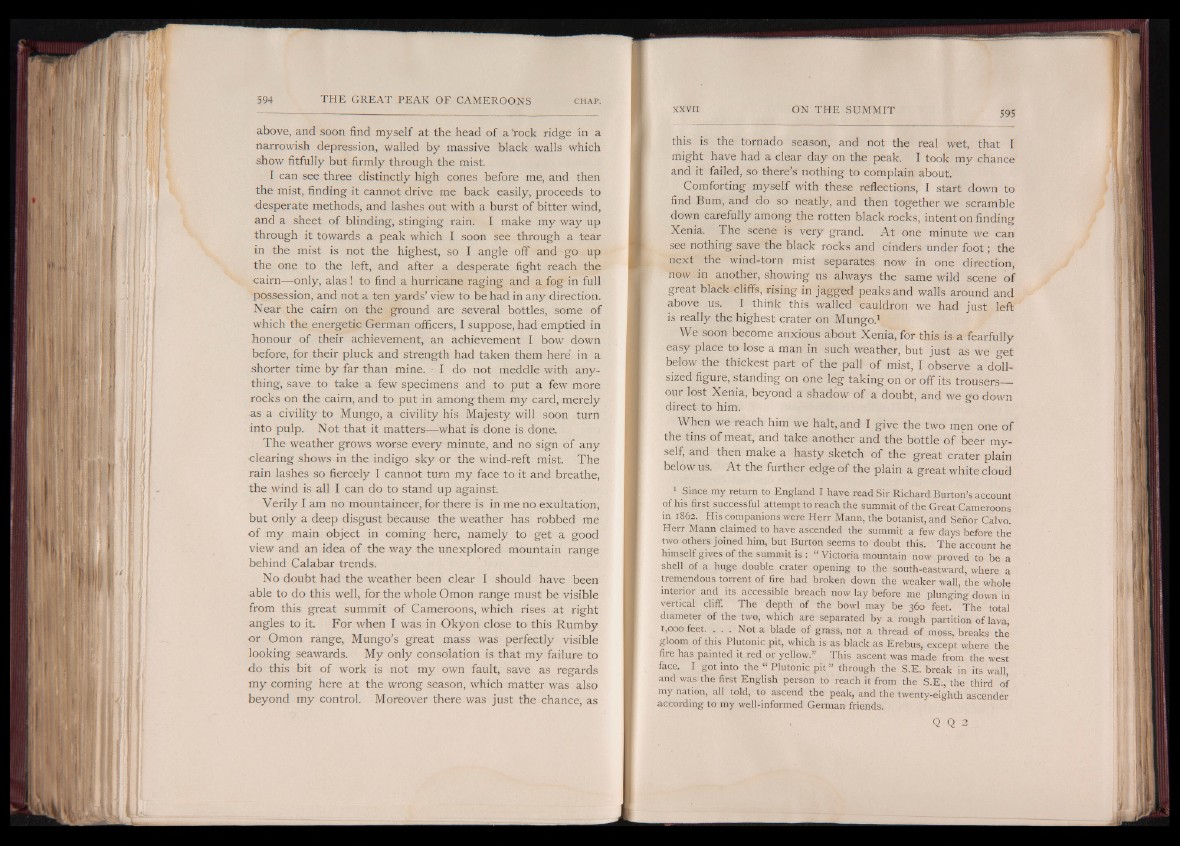
above, and soon find myself at the head of a ’rock ridge in a
narrowish depression, walled by massive black walls which
show fitfully but firmly through the mist.
I can see three distinctly high cones before me, and then
the mist, finding it cannot drive me back easily, proceeds to
desperate methods, and lashes out with a burst of bitter wind,
and a sheet of blinding, stinging rain. I make my way up
through it towards a peak which I soon see through a tear
in the mist is not the highest, so I angle off and go up
the one to the left, and after a desperate fight reach the
■cairn— only, alas ! to find a hurricane raging and a fog in full
possession, and not a ten yards’ view to be had in any direction.
Near the cairn on the ground are several bottles, some of
which the energetic German officers, I suppose, had emptied in
honour of their achievement, an achievement I bow down
before, for their pluck and strength had taken them here* in a
shorter time by far than mine. I do not meddle with anything,
save to take a few specimens and to put a few more
rocks on the cairn, and to put in among them my card, merely
as a civility to Mungo, a civility his Majesty will soon turn
into pulp. Not that it matters— what is done is done.
The weather grows worse every minute, and no sign of any
clearing shows in the indigo sky or the wind-reft mist. The
rain lashes so fiercely I cannot turn my face to it and breathe,
the wind is all I can do to stand up against.
Verily I am no mountaineer, for there is in me no exultation,
but only a deep disgust because the weather has robbed me
o f my main object in coming here, namely to get a good
view and an idea of the way the unexplored mountain range
behind Calabar trends.
No doubt had the weather been clear I should have been
able to do this well, for the whole Omon range must be visible
from this great summit of Cameroons, which rises at right
angles to it. For when I was in Okyon close to this Rumby
or Omon range, Mungo’s great mass was perfectly visible
looking seawards. My only consolation is that my failure to
do this bit of work is not my own fault, save as regards
my coming here at the wrong season, which matter was also
beyond my control. Moreover there was just the chance, as
this is the tornado season, and not the real wet, that I
might have had a clear day on the peak. I took my chance
and it failed, so there’s nothing to complain about.
Comforting myself with these reflections, I start down to
find Bum, and do so neatly, and then together we scramble
down carefully among the rotten black rocks, intent on finding
Xenia. The scene is very grand. A t one minute we can
see nothing save the black rocks and cinders under foot; the
next the wind-torn mist separates now in one direction,
now in another, showing us always the same wild scene of
great black cliffs, rising in jagged peaks and walls around and
above us. I think this walled cauldron we had just left
is really the highest crater on Mungo.1
We soon become anxious about Xenia, for this is a fearfully
easy place to lose a man in such weather, but just as we get
below the thickest part of the pall of mist, I observe a dollsized
figure, standing on one leg taking on or off its trousers_
our lost Xenia, beyond a shadow of a doubt, and we go down
direct to him.
When we reach him we halt, and I give the two men one of
the tins of meat, and take another and the bottle of beer myself,
and then make a hasty sketch of the great crater plain
below us. At the further edge of the plain a great white cloud
1 Since my return to England I have read Sir Richard Burton’s account
of his first successful attempt to reach the summit of the Great Cameroons
in 1862. His companions were Herr Mann, the botanist, and Señor Calvo.
Herr Mann claimed to have ascended the summit a few days before the
two others joined him, but Burton seems to doubt this. The account he
himself gives of the summit is : “ Victoria mountain now proved to be a
shell of a huge double crater opening to the south-eastward, where a
tremendous torrent of fire had broken down the weaker wall, the whole
interior and its accessible breach now lay before me plunging down in
vertical cliff. The depth of the bowl may be 360 feet. The total
diameter of the two, which are separated by a rough partition of lava,
1,000 feet. . . . Not a blade of grass, not a thread of moss, breaks the
gloom of this Plutonic pit, which is as black as Erebus, except where the
fire has painted it red or yellow.” This ascent was made from the west
face. I got into the “ Plutonic p it” through the S.E. break in its wall,
and was the first English person to reach it from the S.E., the third of
my nation, all told, to ascend the peak, and the twenty-eighth ascender
according to my well-informed German friends.